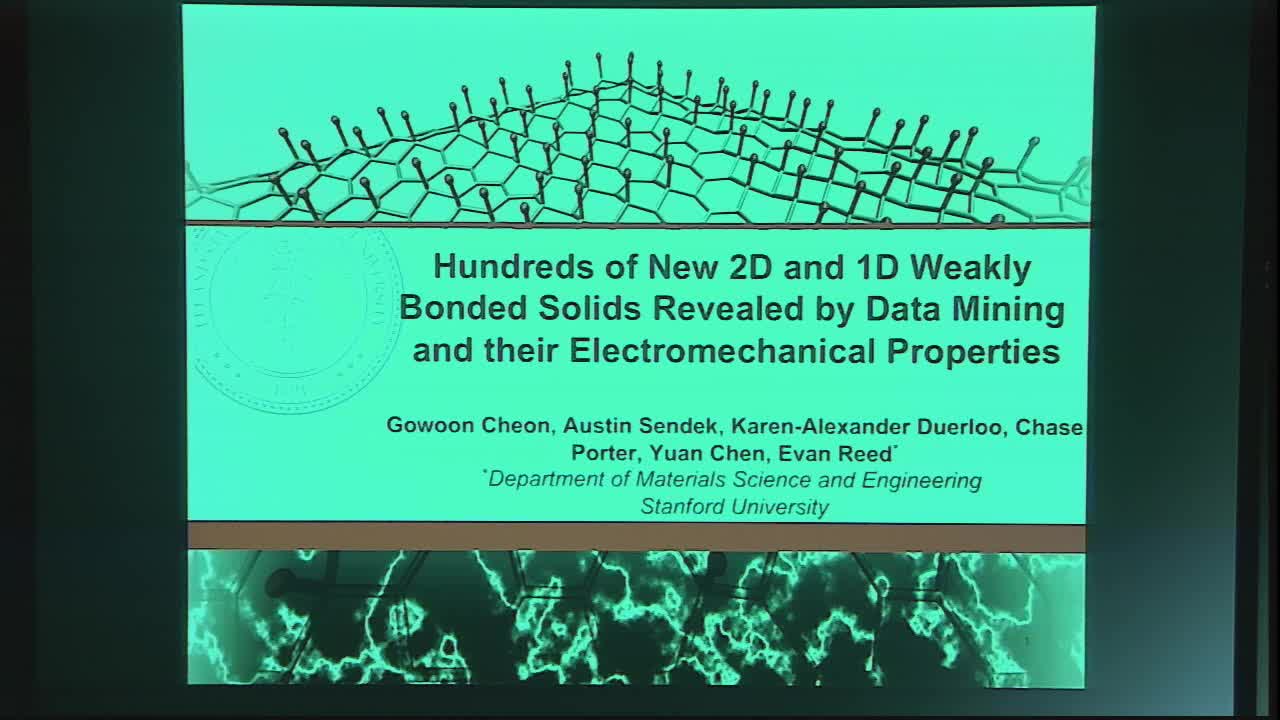Emergent Phase Change and Electromechanical Properties of Two-Dimensional and Few-Layer Mater
Presenter
May 17, 2017
Keywords:
- 2D material, MoTe2, WTe2, piezoelectricity, phase change, database, van der Waals, Lifshitz
Abstract
Some of the most dramatic engineering feats accomplished with layered materials are enabled by properties that emerge only at the single or few-layer limit and are not found in bulk forms. I will discuss our efforts to elucidate useful emergent properties of monolayer and few-layer materials, including our predictions and several recent experimental observations of substantive electromechanical coupling in the form of piezoelectric1–3 and flexoelectric-like effects,4 unlike their bulk forms. Single-layers of some transition metal dichalcogenide compounds have the potential to exist in more than one crystal structure, leading to phase change application possibilities. By developing electronic structure-based computational approaches, we have discovered that mechanical deformations,5 electrostatic gating,6 and temperature changes7 all independently have the potential to control phase changes in some specific 2D materials and their alloys. I will elucidate the essential aspects of thermodynamic constraints for 2D materials, and contrast with those of 3D materials.
I will also discuss our recent data mining efforts to elucidate over 1000 2D materials, 300 piezoelectric 2D materials, and several hundred 3D materials consisting of van der Waals bonded 1D subcomponents, or molecular wires.3 These materials expand the list of known materials by factors of more than 5 and are publicly available in the supporting information of Ref. 3. Finally, I will give an overview of our efforts to quantify the magnitude of van der Waals effects in layered materials using a Lifshitz-based model, the role of two and three-body interactions, and the potential for anomalous effects including repulsive van der Waals interactions between layers.8
References
1. Duerloo, K.-A. N., Ong, M. T. & Reed, E. J. Intrinsic Piezoelectricity in Two-Dimensional Materials. J. Phys. Chem. Lett. 3, 2871–2876 (2012).
2. Ong, M. T. & Reed, E. J. Engineered piezoelectricity in graphene. ACS nano 6, 1387–94 (2012).
3. Cheon, G. et al. Data Mining for New Two- and One-Dimensional Weakly Bonded Solids and Lattice-Commensurate Heterostructures. Nano Letters 17, 1915–1923 (2017).
4. Duerloo, K.-A. N. & Reed, E. J. Flexural electromechanical coupling: a nanoscale emergent property of boron nitride bilayers. Nano letters 13, 1681–6 (2013).
5. Duerloo, K.-A., Li, Y. & Reed, E. J. Structural Phase Transitions in Two-Dimensional Mo- and W-Dichalcogenide Monolayers. Nature Communications 5, 4214 (2014).
6. Li, Y., Duerloo, K.-A. N., Wauson, K. & Reed, E. J. Structural semiconductor-to-semimetal phase transition in two-dimensional materials induced by electrostatic gating. Nature Communications 7, 10671 (2016).
7. Duerloo, K.-A. N. & Reed, E. J. Structural Phase Transitions by Design in Monolayer Alloys. ACS Nano 10, 289–297 (2016).
8. Zhou, Y., Pellouchoud, L. A. & Reed, E. J. The potential for fast van der Waals computations for layered materials using a Lifshitz model. 2D Materials 4, 025005 (2017).
